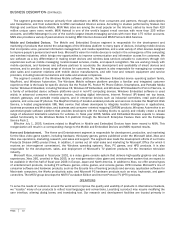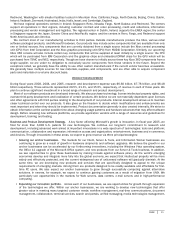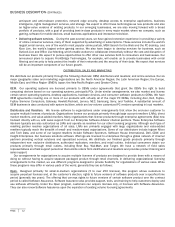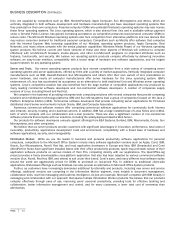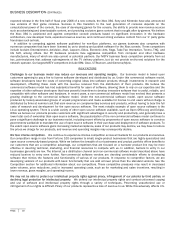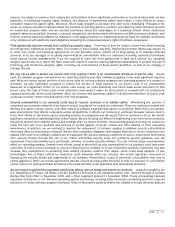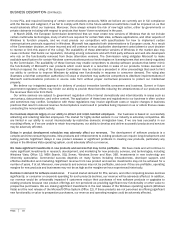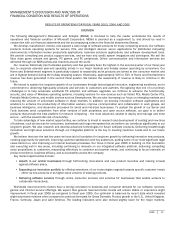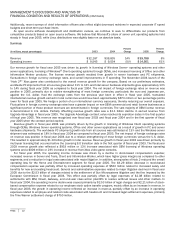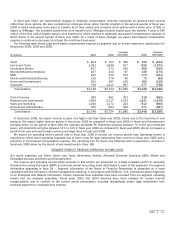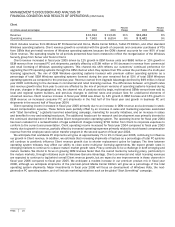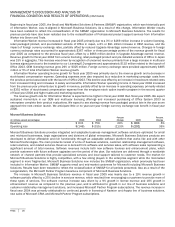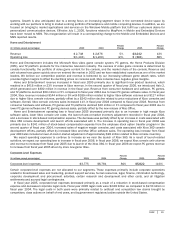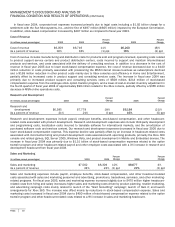Microsoft 2005 Annual Report Download - page 21
Download and view the complete annual report
Please find page 21 of the 2005 Microsoft annual report below. You can navigate through the pages in the report by either clicking on the pages listed below, or by using the keyword search tool below to find specific information within the annual report.
BUSINESS DESCRIPTION (CONTINUED)
PAGE 20
General economic and geo-political risks may affect our revenue and profitability. Softness in corporate information
technology spending or other changes in general economic conditions that affect demand for computer hardware or software
could adversely affect our revenue. Abrupt political change, terrorist activity and armed conflict pose a risk of general economic
disruption in affected countries or generally and could require changes in our operations and security arrangements, thus
increasing our operating costs. These conditions may lend additional uncertainty to the timing and budget for technology
investment decisions by our customers.
Catastrophic events may disrupt our business. We are a highly automated business and a disruption or failure of our systems
in the event of a major earthquake, cyber-attack, terrorist attack, or other catastrophic event could cause delays in completing
sales and providing services. Our corporate headquarters, a significant portion of our research and development activities, and
certain other critical business operations are located in the Seattle, Washington area, and we have other business operations in
the Silicon Valley area of California, both of which are near major earthquake faults. A catastrophic event that results in the
destruction or disruption of any of our critical business or information technology systems could severely affect our ability to
conduct normal business operations and, as a result, our future operating results could be adversely affected.
Acquisitions and joint ventures may have an adverse effect on our business. We expect to continue making acquisitions or
entering into joint ventures as part of our long-term business strategy. These transactions involve significant challenges and
risks including that the transaction does not advance our business strategy, that we don’t realize a satisfactory return on the
investment we make, or that we may experience difficulty in the integration of new employees, business systems and
technology, or diversion of management’s attention from our other businesses. These factors could adversely affect our
operating results or financial condition.
We have limited insurance. We maintain third party insurance coverage against various liability risks and risks of property loss.
Because of the unavailability or high cost of conventional insurance arrangements, we have entered into captive insurance
arrangements for the purpose of protecting against possible catastrophic and other risks not covered by traditional insurance
markets. As of June 30, 2005, the face value of captive insurance arrangements was $2.0 billion. Actual value at any particular
time will vary due to deductibles, exclusions, other restrictions, and claims. While we believe these arrangements are an
effective way to insure against liability and property damage risks, the potential liabilities associated with the risks discussed in
this report or other events could exceed the coverage provided by such arrangements.
Other risks that may affect our business. Other factors that may affect our performance may include:
• sales channel disruption, such as the bankruptcy of a major distributor;
• our ability to implement operating cost structures that align with revenue growth; and
• the continued availability of third-party distribution channels for MSN service and other online services.
EMPLOYEES
As of June 30, 2005, we employed approximately 61,000 people on a full-time basis, 39,000 in the United States and 22,000
internationally. Of the total, 24,000 were in product research and development, 18,000 in sales and marketing, 12,000 in
product support and consulting services, 2,000 in manufacturing and distribution, and 5,000 in general and administration. Our
success is highly dependent on our ability to attract and retain qualified employees. Competition for employees is intense in the
software industry. We believe we have been successful in our efforts to recruit qualified employees, but we cannot guarantee
that we will continue to be as successful in the future. None of our employees are subject to collective bargaining agreements.
We believe that our relationship with our employees is excellent.
AVAILABLE INFORMATION
Our Internet address is www.microsoft.com. There we make available, free of charge, our annual report on Form 10-K, quarterly
reports on Form 10-Q, current reports on Form 8-K, and any amendments to those reports, as soon as reasonably practicable
after we electronically file such material with or furnish it to the SEC. Our SEC reports can be accessed through the investor
relations section of our Web site. The information found on our Web site is not part of this or any other report we file with or
furnish to the SEC.


